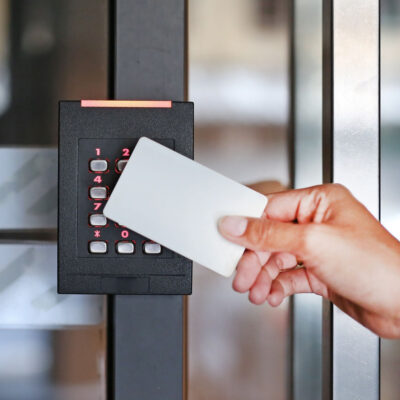
The Evolution of Access Control: From Traditional Locks to Biometric Systems
In commercial security systems, the journey from traditional locks to advanced biometric systems is nothing short of fascinating. This evolution not only reflects the advancements in technology but also the ever-changing needs of businesses and individuals in ensuring safety and security.
The Humble Beginnings: Traditional Locks
The concept of access control is as old as civilization itself. Ancient societies utilized physical barriers and guards to protect their territories and valuables. The traditional lock and key mechanism, which many of us are familiar with, has its roots in ancient civilizations. These rudimentary systems served their purpose for a time. Still, as societies grew and the need for more sophisticated security measures became apparent, the world of access control began its transformative journey.
The Advent of Electronic Access Control
The latter half of the 20th century saw a significant shift in how access control was perceived and implemented. With the rise of commercial establishments and the increasing challenges of managing large infrastructures, electronic access control systems emerged as a solution. These systems, often provided by specialized security system suppliers, offered security and flexibility that traditional locks couldn’t match.
Key pads, one of the earliest forms of electronic access control, required users to input a PIN for access. This was a significant step up from traditional keys, which could be easily lost or duplicated. However, as technology evolved, so did the methods of access control.
Card Readers and Beyond
The introduction of card readers marked a significant milestone in the evolution of access control. These devices used magnetic strips on plastic cards (often key cards) to grant or deny access. Not only did this eliminate the challenges associated with lost or forgotten keys, but it also allowed businesses to monitor and record access data, providing invaluable insights into the comings and goings within an establishment. However, access control was set for another revolution with the advent of biometric systems.
Biometric Systems: The Pinnacle of Access Control
Biometric systems represent the cutting edge of access control technology. Instead of relying on something you have (like a key or a card) or something you know (like a PIN), biometric systems rely on something you are. This could be a fingerprint, a retina scan, or facial recognition patterns. The benefits of such access control security systems are manifold:
- Increased Security: Biometric identifiers are unique to each individual, making them incredibly difficult to duplicate or forge.
- Ease of Use: No more forgotten PINs or lost access cards. Your identity is always with you.
- Efficiency: Biometric systems offer quick and seamless access, reducing wait times and improving user experience.
Today, many commercial security systems integrate biometric technology, offering businesses a level of security that was once thought to be the stuff of science fiction.
The Role of Security System Suppliers
In this evolving landscape, the role of security system suppliers cannot be understated. These suppliers are at the forefront of technological advancements, ensuring businesses can access the latest and most effective access control solutions. Their expertise not only ensures that establishments are secure but also that they are equipped to face the security challenges of the future.
Conclusion
The world of access control has come a long way from its humble beginnings. From traditional locks to the advanced biometric systems of today, this evolution reflects the ever-growing needs of businesses and individuals in a rapidly changing world. As technology advances, one can only imagine the future of access control. But one thing is certain: the importance of robust and effective commercial security systems will never diminish.
Back to "The Security Center, Inc. Blog"